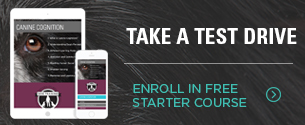Where do we start when framing conversations about aggressive behaviors in dogs?

It’s deceptively easy to think of actions such as snarling, snapping, lunging, and biting as all being the same. But Victoria reminds us that dog behavior can be nuanced, and that we need to observe closely and consider our words.
Victoria held a roundtable with the Positively team to discuss this important issue. Here are some highlights of that conversation.
Defining Aggression
Positive trainers need to think carefully about any dog behavior that could be described as “aggressive.” Like us, dogs want to protect themselves. If we, as humans, feel that our own safety or well-being are in jeopardy, we might try to avoid that situation and run away as best we can, or we might try to calm and appease those who pose a threat.
But when we’ve run out of options, and if our survival is on the line, we could feel forced to fight—even if we don’t usually consider ourselves a violent person. In what feels like a crisis, people can and do resort to aggressive behavior to survive.
Without human language or much control over their environments, dogs have limited options for expressing their needs and may resort to aggressive behavior to communicate and influence their environment.
Aggressive behavior is a part of the natural drive for survival. Behaviors like growling and snapping can serve as a warning and an attempt to increase their own safety as efficiently as possible.
LEARN MORE ABOUT HOW MANAGING AGGRESSION IS TAUGHT IN VSA’S DOG TRAINER COURSE
Aggressive versus Predatory
Whether you’re talking to ordinary dog lovers, animal behavior scientists, or dog industry professionals, it’s easy to get drawn into a highly charged discussion about dog behaviors such as growling, snarling, snapping, and biting. So we want to use language carefully and consider what a behavior is achieving for the dog. When we talk about aggression, we generally mean behavior that helps the dog increase distance from a perceived threat.
Aggressive behavior and a predatory bite can both have severe consequences, but they are not the same thing. Aggression based on fear, for example, serves to increase distance. Predatory behaviors instead serve to reduce distance, because their goal is ultimately to grab and consume.
Dogs give us clues through their body language that can help us recognize when they’re not feeling comfortable and want more distance. We want to avoid punishing a dog for expressing their fear or need for distance, because they may stop giving warning signs and simply escalate to make their point.
The safest solution is to help them exit, and at minimum tolerate, a situation that they aren’t equipped to handle comfortably. We want to find ways to adjust the situation so that it becomes less distressing for the dog.
The Risks of Labeling
Even though our human brains are wired to judge, first impressions might be completely wrong. We do a dog a disservice when we pigeonhole them with sweeping labels such as “aggressive” or “reactive.”
Instead, if we hit “pause” on labeling, we can think of aggressive behavior as the dog showing us how he or she feels in the moment. We focus first on behavior and avoid assigning labels that become unhelpful.
We want to look at why the dog is aggressing in a particular environment, in a particular context and moment, with this specific person, or dog or situation. Any of us can appear aggressive at certain times. Those moments could be very specific to circumstances where we feel our survival and wellbeing, or that of someone we love, are threatened.
From Their Perspective
Dogs on a leash have restricted movement and can feel trapped and vulnerable. Often, dogs are unable to exit a situation without our cooperation. So we can learn to read the signs and advocate for them. They depend on us for help.
We tend to see a dog’s behavior with more respect and dignity when we recognize there is an underlying cause. Something is happening in the situation that is provoking feelings and this response.
For example, perhaps you’re walking your dog down the road and see a little yard or garden flag flapping in the wind. Suddenly it looks like your dog is losing his mind, barking and lunging angrily. Your first thought might be that this reaction is completely inappropriate–but really, from the dog’s perspective, that sight is scary. The dog is doing his best to try to put himself in a safer situation.
We don’t have to understand it or comprehend what the dog finds threatening–it could even be a paper bag flying through the air—but we can recognize that they are showing us what they are feeling. Then it is up to us to understand that and to help them through the challenging situation, by safely helping them get distance. And we work to prevent similar situations in the future, whether by managing their proximity to the trigger, resolving undiagnosed pain the dog is experiencing, or helping change their emotional reaction by building positive associations.
Listen to the Positively team’s thoughtful roundtable discussion on this complicated issue.
When have you noticed dog body language that signals need for more distance? Visit the Victoria Stilwell Academy on Facebook to let us know.
To learn more about reading dog body language and supporting dogs that struggle in a variety of situations, check out our Dog Trainer Course.



